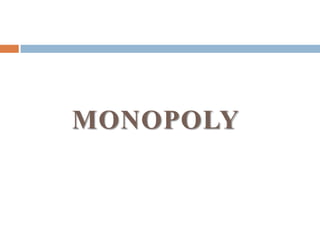
Monopoly
- 1. MONOPOLY
- 2. INTRODUCTION A monopoly is a market structure in which there is a single supplier of a product. Monopolies exist because of barriers to entry into a market that prevent competition. The monopoly firm (monopolist): May be small or large. Must be the only supplier of the product. Sells a product for which there are only close substitutes.
- 3. TYPES OF MONOPOLY Natural monopoly: A monopoly that arises from economies of scale. The economies of scale arise from natural supply and demand conditions, and not from government actions. Local monopoly: a monopoly that exists in a limited geographic area. Regulated monopoly: a monopoly firm whose behavior is overseen by a government entity. Monopoly power: market power, the power to set prices. Monopolization: an attempt by a firm to dominate a market or become a monopoly.
- 4. AVERAGE AND MARGINAL REVENUE UNDER MONOPOLY In the case of monopoly one firm constitutes the whole industry. Therefore, the entire demand of the consumers for a product faces the monopolist. Since the demand curve of the consumers for a product slopes downward, the monopolist faces a downward sloping demand curve .
- 5. AVERAGE AND MARGINAL REVENUE CURVES UNDER MONOPOLY ARandMR Quantity Q M K P Y AR MR
- 6. CHARACTERISTICS OF MONOPOLY There is only a single seller of a product or service in the market . The goods produced by a sole seller have not close substitutes. The entry of new firm into the industry is effectively bared by legal or natural barriers. The firm being the sole supplier of a product constitutes industry. Firm and industry thus have single identity.
- 7. BARRIER TO ENTRY Anything that impedes the ability of firms to begin a new business in an industry in which existing firms are earning positive economic profits. There are general classes of barriers to entry: Natural barriers Technological barriers Sociological barriers Government (legal) barriers
- 8. Natural barriers – The firm has a unique ability to produce what other firms can’t duplicate. Technological barriers – The size of the market can support only one firm. Sociological barriers – Entry is prevented by custom or tradition. Government barriers – Governments often provide barriers, creating monopolies. As incentives to innovation, governments often grant patents, providing firms with legal monopolies on their products or the use of their inventions or discoveries for a certain period.
- 9. MONOPOLY PRICE DISCRIMINATION The practice on the part of the monopolist to sell the identical goods at the same time to different buyers at different prices when the price difference is not justified by in difference in cost is called Price Discrimination.
- 10. CONCLUSION Market structure with one producer. Entry of firm is ban unique product or no close substitute firm is price maker The monopolist can take the market demand curve as its own demand curve. A monopolist therefore faces a downward sloping.
- 11. THANK YOU…
